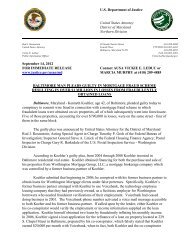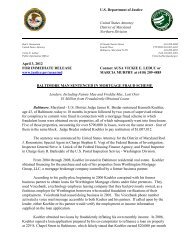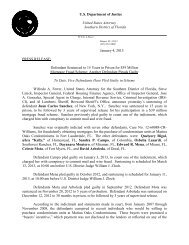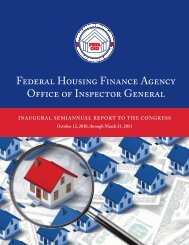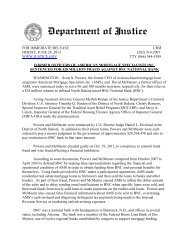FEDERAL
Sixth Semiannual Report to the Congress - Federal Housing ...
Sixth Semiannual Report to the Congress - Federal Housing ...
- No tags were found...
Create successful ePaper yourself
Turn your PDF publications into a flip-book with our unique Google optimized e-Paper software.
Siloed Practices: Harmonizing Business<br />
and Sharing Information<br />
As part of its larger effort to prepare the housing<br />
finance market for reform, FHFA has undertaken<br />
several strategic initiatives to standardize and<br />
harmonize various aspects of the secondary mortgage<br />
market.<br />
For example, in May 2010, FHFA announced the<br />
Uniform Mortgage Data Program, a long-term joint<br />
effort with the enterprises to create uniform data<br />
standards and collection processes. FHFA believes<br />
that a common framework will result in better lender<br />
efficiency and enterprise risk management. Likewise,<br />
common data standards are expected to lead to<br />
appraisers, lenders, servicers, etc., submitting more<br />
consistent data. The enterprises will deploy the data<br />
standards program in phases through a common<br />
platform that will include stakeholder input. 207<br />
Also, in September 2012, FHFA announced that<br />
the enterprises will launch a new representation<br />
and warranty framework for conventional loans<br />
sold or delivered after 2012. The framework aims<br />
to limit and clarify lenders’ repurchase exposure<br />
and liability on mortgages originated in 2013 and<br />
thereafter. It is also part of a broader series of strategic<br />
initiatives directed toward seller/servicer contract<br />
harmonization, as outlined in FHFA’s A Strategic Plan<br />
for Enterprise Conservatorships. 208<br />
For example, FHFA has instructed the enterprises<br />
to establish a single, consistent set of procedures<br />
for servicing mortgages they own or guarantee.<br />
Key elements of this Servicing Alignment Initiative<br />
include streamlined requirements, simplified loan<br />
modifications, and performance-based incentives<br />
for servicers to focus them on reviewing foreclosure<br />
alternatives in a timely manner. 209 According to<br />
the FHFA Acting Director, this alignment “should<br />
result in earlier servicer engagement to identify the<br />
best solution available for homeowners, given their<br />
individual circumstances.” 210<br />
As part of these solutions, the initiative requires<br />
servicers to focus on remediating delinquencies. For<br />
example, foreclosure cannot start while borrowers and<br />
servicers are engaged in good-faith efforts to resolve<br />
delinquencies. Further, servicers must conduct formal<br />
reviews to ensure they have considered alternatives<br />
to foreclosure before starting the process. Even after<br />
foreclosure begins, servicers have financial incentives<br />
to keep helping borrowers pursue an alternative. 211<br />
In addition to harmonizing operations, the<br />
enterprises can benefit from sharing information<br />
and consistent application of servicing rules. For<br />
example, during our review of reported abuse by law<br />
firms processing enterprise foreclosures, we identified<br />
instances where Freddie Mac terminated problematic<br />
law firms while Fannie Mae continued to do business<br />
with some of them. 212 Similarly, another report<br />
disclosed that FHFA does not facilitate information<br />
sharing regarding high-risk counterparties even<br />
though the enterprises may use the same ones. As of<br />
September 2011, the two enterprises had separately<br />
identified over 300 servicers as high risk with a<br />
total risk exposure of $7.2 billion. 213 Although the<br />
enterprises separately monitor high-risk servicers,<br />
they do not communicate with each other about<br />
them, which can leave each vulnerable to the risks<br />
the other has identified. Indeed, in January 2000, a<br />
Fannie Mae executive discovered that a counterparty<br />
that worked with both enterprises had sold the same<br />
loans to more than one entity including Fannie Mae.<br />
In April 2002, Fannie Mae ended its relationship<br />
with the company due to possible fraud, but it did<br />
not report the termination to law enforcement or<br />
outside the enterprise. FHFA’s predecessor agency was<br />
aware of the termination but not its basis. 214<br />
Consequently, Freddie Mac continued to conduct<br />
business with the company without intervention.<br />
Semiannual Report to the Congress • April 1, 2013–September 30, 2013 69



